Focus Bracketing
Focus bracketing enables continuous shooting with the focal distance changed automatically after a single shot. From these images, you can create a single image in focus over a wide area by using an application that supports depth compositing, such as Digital Photo Professional (EOS software).
-
Select [
: Focus bracketing].
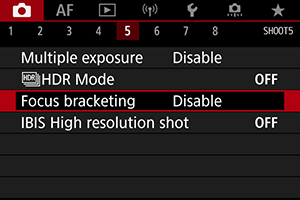
-
Set [Focus bracketing].
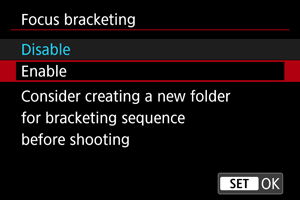
- Select [Enable].
-
Set [Number of shots].
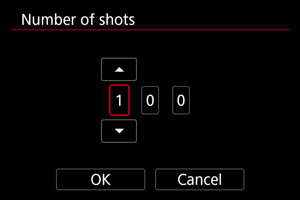
- Specify the number of images captured per shot.
- Can be set in a range of [2]–[999].
-
Set [Focus increment].
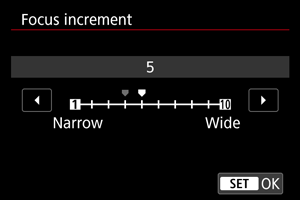
-
Specify how much to shift the focus. This amount is automatically adjusted to suit the aperture value at the time of shooting.
Larger aperture values increase the focus shift and make focus bracketing cover a wider range under the same focus increment and number of shots.
- After completing the settings, press
.
-
-
Set [Exposure smoothing].
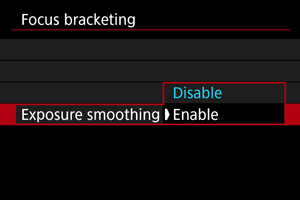
- You can suppress changes in image brightness during focus bracketing by setting [Exposure smoothing] to [Enable], which compensates for differences between the displayed and actual aperture value (effective f/number), which varies by focal position.
-
Take the picture.
- To save your shots in a new folder, tap [
] and select [OK].
- Focus at the nearer end of your preferred focal range, then press the shutter button completely.
- Once shooting begins, release the shutter button.
- The camera shoots continuously, shifting the focal position toward infinity.
- Shooting ends after your specified number of images, or at the far end of the focal range.
- To save your shots in a new folder, tap [
Caution
- Focus bracketing is intended for still photo shooting on a tripod.
- Shooting with a wider angle of view is recommended. After depth compositing, you can crop the image if necessary.
- For details on lenses compatible with this feature, visit the Canon website.
- Set [Exposure smoothing] to [Disable] with the following lenses, because they may cause changes in image brightness.
- EF100mm f/2.8L Macro IS USM
- EF180mm f/3.5L Macro USM
- EF-S60mm f/2.8 Macro USM
- Suitable [Focus increment] settings vary by subject. An unsuitable [Focus increment] setting may cause unevenness in composite images, or shooting may take more time because more shots are taken. Take some test shots to decide a suitable [Focus increment] setting.
- Combining the images will take longer when you have specified a higher numbers of shots.
- Flash photography is not possible.
- Shooting under flickering light may cause uneven images. In this case, lowering the shutter speed may give better results.
- Focus bracketing is not available when the lens's focus mode switch is set to
.
- Canceling shooting in progress may cause exposure problems in the last image. Avoid using the last image when combining the images in Digital Photo Professional.
Note
- Using a tripod, remote switch (sold separately, ), or wireless remote control (sold separately, ) is recommended.
- For best results, set the aperture value in a range of f/5.6–11 before shooting.
- Details such as shutter speed, aperture value, and ISO speed are determined by conditions for the first shot.
- To cancel shooting, press the shutter button completely again.
- [Focus bracketing] reverts to [Disable] when the power switch is set to
.